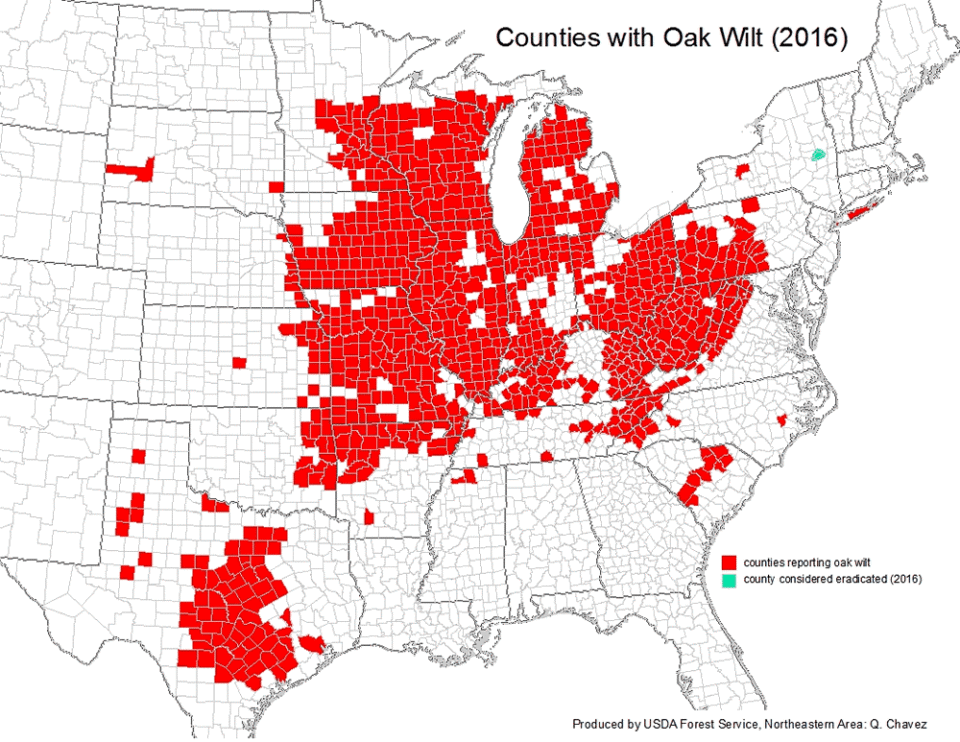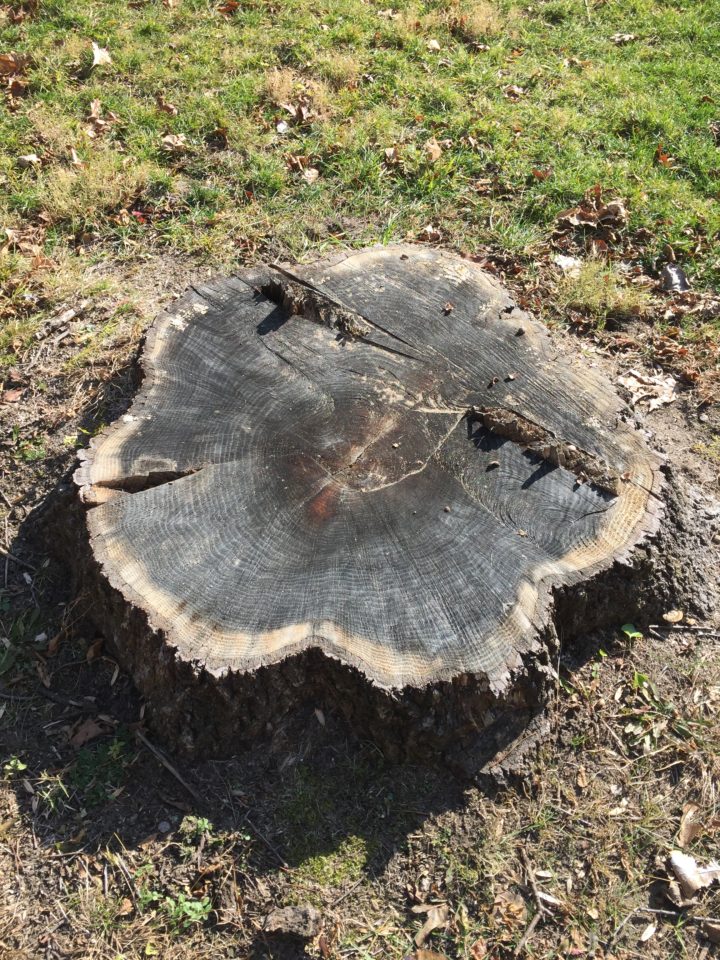Oak wilt is a fungal disease that has devastating effects on oak trees. We are dealing with oak wilt at Camp Friedenswald and continue to learn more about it. It seems many people are not aware of the danger of oak wilt to oak trees and the simple preventative measures one can take against it. Perhaps this blog post will save a few oak trees, through increased awareness of oak wilt, as well as letting our readers in on the situation we face with oak wilt’s presence at and near to Camp.
What is oak wilt?
Oak wilt is a fungal disease that attacks oak trees. Red oaks are especially susceptible, often dying within a month of infection. White oaks can be a bit more resistant, with death taking a number of years or, in some cases, even surviving.
Oak trees can be infected with oak wilt either through overland transmission of fungal spores via sap beetles or underground through the interconnected root grafts from infected trees. The sap beetles are attracted to wounds on oak trees from pruning, fallen limbs and other injuries. According to retired Michigan State University professor and oak wilt expert, Dr. David Roberts, the sap beetles that spread oak wilt can smell a fresh wound in a tree from up to eight miles away! The spread through tree roots is also deadly, with the roots of different oaks grafting onto each other and infecting and eventually killing all the interconnected trees in an area.

Identification
If an oak tree drops its leaves in the middle of summer, beware! Oak wilt causes leaves to brown and die rapidly. The visual effects usually start in the crown of the tree, and then, in a matter of a few weeks, many/most leaves die and fall to the ground. Effected leaves range in color from normal green to olive green to tan, with tan leaves sometimes remaining attached to the branches. Here at Camp we’ve used observations like this to identify oak wilt, and have also sent in branch samples for testing to Michigan State University in order to be sure oak wilt is the issue. Dr. Roberts strongly advises obtaining an accurate diagnosis, as oak wilt can be confused with other tree diseases.
Prevention
“Through science and decades of observations, there are high risk periods of the year, generally from April 1-July 15, when overland spread of oak wilt is more likely to occur,” states Dr. Roberts. If pruning needs to be done on oak trees, even “dead-wooding”, Dr. Roberts recommends pruning oaks from December 1st through April 1st – or when temperatures remain below 45 degrees Fahrenheit for at least seven days. If a tree is wounded in the growing season, you can simply paint the wound to prevent the sap beetles from being attracted to the wound. The faster you act, the better – the beetles can arrive in as little as five minutes and are attracted to the wound for up to seven days. “A wound created by storm damage is just as attractive to sap beetles and oak wilt as pruning cuts. If storm injury occurs I recommend removing the injured portion from the tree within a couple of days of the injury and immediately painting the fresh cut with a protective sealer,” states Dr. Roberts.
Measures to take once oak wilt is present
Once you know oak wilt is present in a red oak tree, that infected tree cannot generally be saved. The primary focus should be taking measures to prevent the disease from spreading to other nearby oak trees. There are a few different strategies that can be used to keep oak wilt from spreading. Here are possible measures (provided by Dr. Roberts):
- Trenching between trees at least 5-6 feet deep around the infected tree to sever grafted roots between trees to prevent the spread through its roots,
- Tree injections with fungicides for 6-8 years
- Use of a trunk girdling/herbicide technique to prevent spread of the fungus through root grafts.
“Depending on the situation, these techniques may be used singly or together to remediate oak wilt on a particular site. Infected trees can be utilized for firewood, but it is strongly advised to seal the firewood under plastic for the first year after infection to prevent sap beetle visitations and subsequent spread to nearby injured oak trees,” states Dr. Roberts. If you suspect oak wilt is present in a tree, please be sure to obtain expert guidance (beyond this blog post!) for appropriate steps to take. Dr. Roberts warns, “Oak wilt is a costly disease and failure to get the proper assistance can result in additional tree losses and more difficulty in containing oak wilt.”

Oak wilt at Camp Friedenswald
As stated previously, we have had a few oak trees succumb to oak wilt here at Camp in the last few years, and are concerned about its spread. At this point, the known cases have been limited and were located at the base of Turtle Hill. Dr. Roberts has been on site and has consulted with us on best practices for treatments and prevention measures. We’ve had amazing volunteers help with trenching and cutting up and covering the wood from infected trees. We are doing our best to monitor the health of the trees all over Camp, and take appropriate actions to mitigate the spread of the disease.

Oak wilt is a lethal fungal disease that can kill many trees in a short amount of time. Being aware of the presence of oak wilt and understanding measures one can take to prevent its spread will go a long way in protecting the health of woodland and urban oak trees and preserving the important role they play in their communities.

A special thanks to Dr. David Roberts for all his help in educating and advising us about oak wilt, and for his input for this blog in particular. You can find more information in this oak wilt article by Dr. Roberts.
Information also came from the following online resource:
O’Brien, J. G., Mielke, M. E., Starkey, D., & Juzwik, J. (2017, March). How to identify, prevent, and control oak wilt [PDF]. Newtown Square: USDA.
Other helpful links:
Michigan Oak Wilt Organization: https://www.michiganoakwilt.org/
Article on oak wilt by the forest service: https://www.nrs.fs.fed.us/disturbance/invasive_species/oak_wilt/